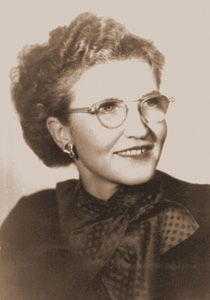Hilda Taba facts for kids
Hilda Taba (born December 7, 1902, in Kooraste, Estonia – died July 6, 1967, in San Francisco, California) was an important educator. She helped shape how schools teach and what students learn. She was also a teacher for other teachers.
Hilda Taba grew up in a small village in Estonia. Her father was a schoolmaster. She went to school in Estonia and earned a degree in English and Philosophy from Tartu University. Later, she got a chance to study in the United States. She earned her master's degree at Bryn Mawr College and then studied at Teachers College at Columbia University.
After her studies, Hilda Taba wanted to work at Tartu University. But she was not hired because she was a woman. Instead, she became a curriculum director at the Dalton School in New York City. In 1951, she became a professor at San Francisco State College, which is now called San Francisco State University.
Hilda Taba's Big Ideas
Hilda Taba was a student of a famous educator named John Dewey. She wrote many books, including seven of her own. Her first major work, Dynamics of Education: A Methodology of Progressive Educational Thought (1932), was about teaching for democracy. She believed that children should learn how to get along with each other in a fair and democratic way.
Taba also thought that learning should be active and connected. She felt that teachers should be responsible for what they teach and how they check student learning. She strongly believed that schools should teach students how to think, not just to remember facts.
After working with other educators like Benjamin Bloom and Ralph W. Tyler, she wrote another important book called Curriculum Development: Theory and Practice (1962). In this book, she wrote about the importance of critical thinking. She said:
It is very important for people in a democratic society to be able to think critically. No matter what people think education is for, they all agree that people need to learn to think. In a world that changes quickly, people cannot just rely on old habits or traditions to make decisions. This is true for everyday things, work, moral choices, or political issues. In such a world, it is natural to want people to be able to think smartly and on their own.
Hilda Taba explained how teachers can help students learn better. She said teachers need to understand three levels of knowledge:
- Facts: These are single pieces of information.
- Basic ideas and principles: These are bigger ideas that connect facts.
- Concepts: These are broad understandings that help students use knowledge from different subjects.
Taba noticed that often, too many facts are taught too quickly. This makes it hard for students to connect new information with what they already know. She said that if facts are just memorized, students might forget them quickly. She believed that basic ideas should be chosen based on what children can learn at their age. Concepts help students use what they know to understand new situations or predict what might happen.
The Taba Approach to Thinking
Hilda Taba was a very inspiring teacher. Even after she passed away, her students continued her work. Many of them used her ideas to create four special thinking strategies. These strategies are known as the Taba approach.
The four strategies are:
- Developing concepts (understanding big ideas).
- Interpreting data (making sense of information).
- Applying generalizations (using what you've learned in new ways).
- Interpreting feelings, attitudes, and values.
The main goal of the Taba approach is to help students think more effectively. To "think" in this way means helping students organize information into patterns. It also means helping them explain how different pieces of information are connected. Students learn to make guesses based on information and test their ideas. They also become aware of how things cause other things to happen, and how things are similar or different.
In the Taba approach, the teacher acts more like a guide than a lecturer. The teacher leads the discussion but encourages students to share their own thoughts. Students are also encouraged to connect their ideas to what their classmates say.
It is very important for the teacher not to judge students' answers. Teachers should not say "Correct" or "That's not quite right." Even smiling or frowning during a student's answer is avoided. The teacher's job is to encourage students to explain their ideas more or to build on what others have said.
Hilda Taba's Impact
Hilda Taba made a huge difference in American education through her teaching and her books.
In 1970, a survey was done with over 200 educators who had learned about the Taba approach. Almost all of them said that her strategies were very helpful in their classrooms. Some teachers even said that Taba's way of teaching was "the most valuable teaching technique they had ever learned." Her ideas continue to influence how we think about teaching and learning today.
See also
 In Spanish: Hilda Taba para niños
In Spanish: Hilda Taba para niños


